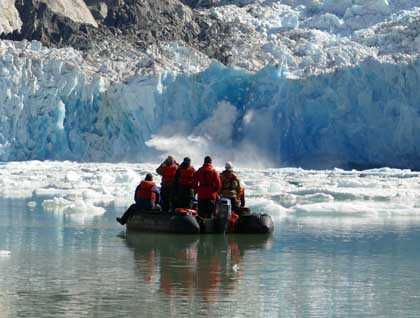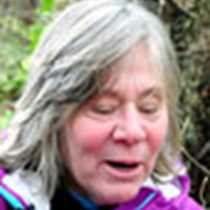We so appreciated the gift of a sunny Alaskan summer day to wend our way eastward toward Canada and the coastal range, following the retreat of the Sawyer glaciers. Towering granite domes dwarfed the Sitka spruce forest and thousand-foot waterfalls cascaded into the ocean waters. Translucent blue sun-lit ice sculptures hove into view, delighting us and igniting our curiosity about what lay ahead. This is one of the world’s most dramatic fjords, and we spent our final day exploring its icy reaches.
By mid-morning the National Geographic Sea Lion slowed near Sawyer Island, not yet in sight of a glacier but at the ice edge John Muir encountered in 1890, when he traveled to Alaska to better understand the glacial process. Cruising in our swift inflatable boats, we skimmed along the fjord wall, marveling at the tortured rocks and tiny waterfalls, and here and there a delicate magenta tuft of dwarf fireweed tucked into a rocky crevice. Above us several mountain goats browsed on tender Sitka alder leaves, moving easily across terrain so steep we had to crane our necks to see them.
Around us, ice. Blue ice. White ice. Bits and bergs, much of it massed together and covered with resting harbor seals. South Sawyer’s seracs rose jaggedly up the mountain and disappeared into the Stikine ice field, high up where the snow falls year round. This glacier is losing more ice than it gains in the high mountains and is receding rather rapidly. As we joyfully experienced the stunning display of calving ice and rode the waves created by the massive displacement of sea water, another part of us sadly recognizes that the ice is changing from solid form into liquid and disappearing into the ocean. Even by tomorrow, this place of deep time will be different, changed by powerful forces and reminding us to cherish our wildest places – both the outer and the inner ones.







